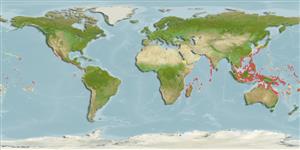Preferred temperature (Ref.
123201): 24.7 - 29.2, mean 28.4 °C (based on 2397 cells).
Índice de diversidade filogenética (Ref.
82804): PD
50 = 1.0000 [Uniqueness, from 0.5 = low to 2.0 = high].
Bayesian length-weight: a=0.00389 (0.00180 - 0.00842), b=3.12 (2.94 - 3.30), in cm total length, based on all LWR estimates for this body shape (Ref.
93245).
Nível Trófico (Ref.
69278): 3.1 ±0.20 se; based on food items.
Resiliência (Ref.
120179): Elevada, tempo mínimo de duplicação da população menor que 15 meses (Preliminary K or Fecundity.).
Fishing Vulnerability (Ref.
59153): Low vulnerability (10 of 100).
🛈
Nutrients (Ref.
124155): Calcium = 167 [81, 333] mg/100g; Iron = 0.802 [0.440, 1.467] mg/100g; Protein = 17.4 [16.1, 18.6] %; Omega3 = 0.125 [0.063, 0.246] g/100g; Selenium = 18.1 [7.4, 45.1] μg/100g; VitaminA = 292 [80, 1,009] μg/100g; Zinc = 2.48 [1.58, 3.70] mg/100g (wet weight);
